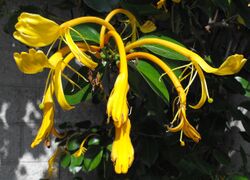Biology:Lonicera hildebrandiana
| Lonicera hildebrandiana | |
|---|---|

| |
| Scientific classification | |
| Kingdom: | Plantae |
| Clade: | Tracheophytes |
| Clade: | Angiosperms |
| Clade: | Eudicots |
| Clade: | Asterids |
| Order: | Dipsacales |
| Family: | Caprifoliaceae |
| Genus: | Lonicera |
| Species: | L. hildebrandiana
|
| Binomial name | |
| Lonicera hildebrandiana Collett & Hemsl.[1]
| |
| Synonyms | |
|
Lonicera braceana Hemsley. | |
Lonicera hildebrandiana, the giant Burmese honeysuckle, is a species of flowering plant in the family Caprifoliaceae, native to southeast Asia, in China (Guanxi and Yunnan), Thailand and Burma at elevations of 1000 to 2300 meters.[2]
Description
Growing to at least 10 m (33 ft) tall and 8 m (26 ft) broad, with flowers and leaves up to 15 cm (5.9 in) long, this climbing, twining shrub is by far the largest of all the honeysuckles. The evergreen leaves are glossy, and the long thin tubular flowers open cream, turning to yellow and orange. The flowers, which have a strong honeysuckle fragrance, appear in pairs intermittently from spring throughout summer, and are followed in autumn by green berries.
Taxonomy
Lonicera hildebrandiana was found in Burma (now Myanmar) in 1888 by Henry Collett, who named it after a local administrator Arthur Hedding Hildebrand, himself an enthusiastic collector. Hildebrand later sent seeds to Kew Gardens for storage and propagation purposes. Since then, specimens have been located in China and Thailand.[3]
Cultivation
This plant does not tolerate frost, so when cultivated in cold temperate areas it must be grown under glass, either in a large conservatory or greenhouse. When grown in warmer temperate zones, it may be planted in a sheltered bay out of direct winter winds until it has grown to a height above the frost-line. A fully grown plant is relatively heavy, especially after rain, so requires strong support as it is not self-supporting.[4] It has been given the Royal Horticultural Society’s Award of Garden Merit.[5][6]
References
- ↑ "Caprifoliaceae Lonicera hildebrandiana Collett & Hemsl.". International Plant Names Index. http://www.ipni.org/ipni/idPlantNameSearch.do?id=148823-1&back_page=%2Fipni%2FeditSimplePlantNameSearch.do%3Ffind_wholeName%3DLonicera%2Bhildebrandiana%26output_format%3Dnormal. Retrieved 28 March 2018.
- ↑ "!Lonicera hildebrandiana Collett & Hemsl.". Tropicos. http://www.tropicos.org/Name/50041256?tab=distribution. Retrieved 28 March 2018.
- ↑ Eade, Simon. "The Giant Burmese Honeysuckle". Seeds of Eaden. http://www.seedsofeaden.com/ornamental-plants-k7/the-giant-burmese-honeysuckle-lonicera-hildebrandiana-b34.html. Retrieved 28 March 2018.
- ↑ "Plantfinder: LONICERA HILDEBRANDIANA". Gardens Online. https://www.gardensonline.com.au/GardenShed/PlantFinder/Show_2426.aspx. Retrieved 28 March 2018.
- ↑ "RHS Plantfinder - Lonicera hildebrandiana". https://www.rhs.org.uk/Plants/83319/i-Lonicera-hildebrandiana-i/Details. Retrieved 28 March 2018.
- ↑ "AGM Plants - Ornamental". Royal Horticultural Society. July 2017. p. 61. https://www.rhs.org.uk/plants/pdfs/agm-lists/agm-ornamentals.pdf. Retrieved 25 March 2018.
Wikidata ☰ Q10935829 entry
 |

